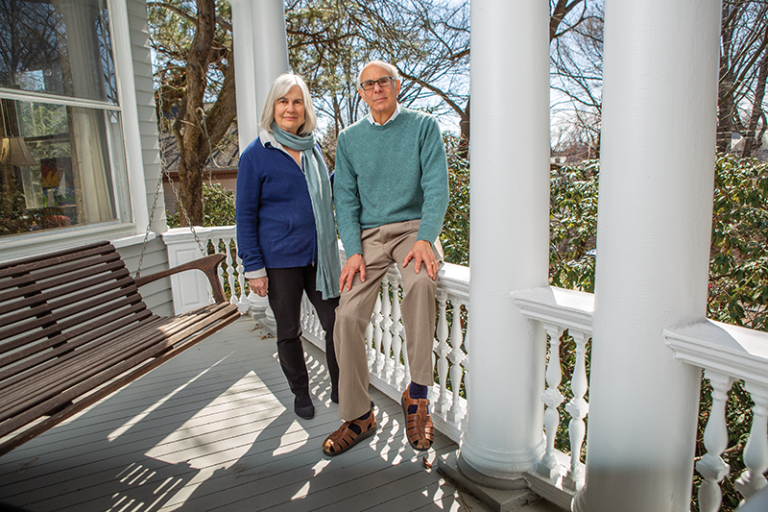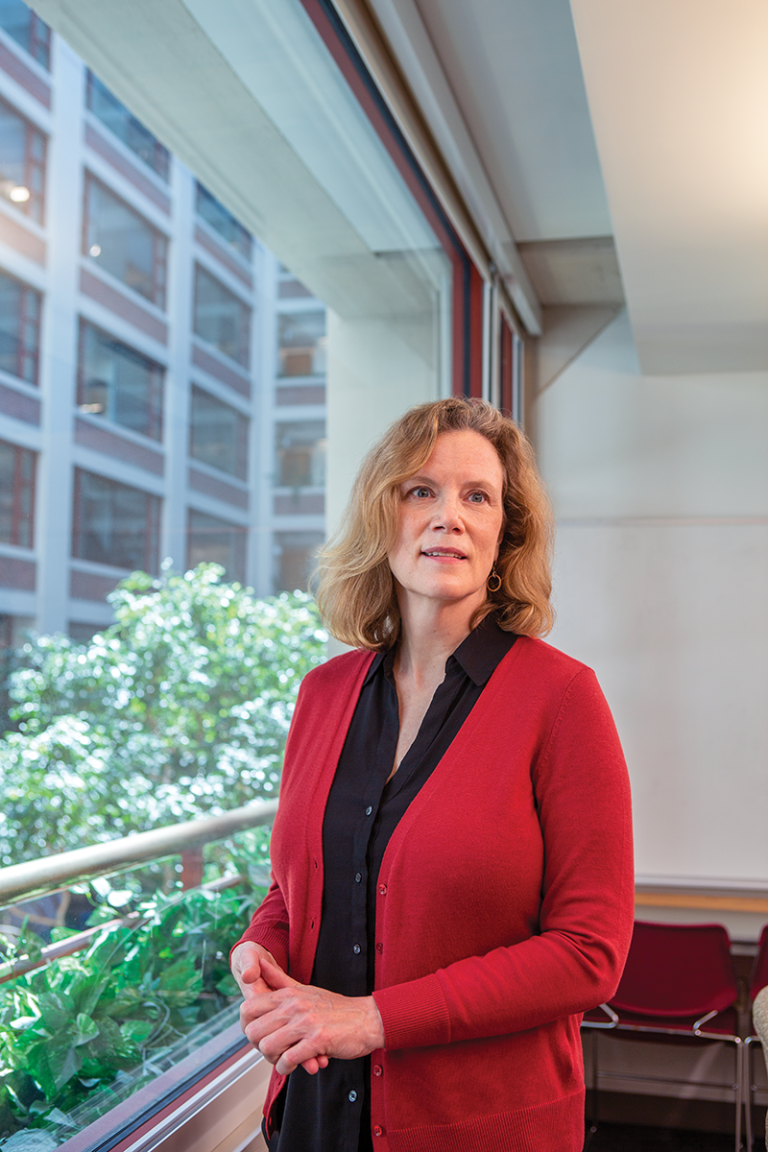Alone in the Crowd
Loneliness among young people is on the rise, sparking concerns over possible damage to their mental and physical health
- 13 minute read
- Feature
Michael Roy Kelly
Ethereal Figure IV, 2022
from The Solitary Figure series
Graphite and china marker on paper
22 x 17 in

Michael Roy Kelly
Ethereal Figure IV, 2022
from The Solitary Figure series
Graphite and china marker on paper
22 x 17 in
Loneliness has been inspiring artists and intellectuals for centuries. In Plato’s Symposium, Aristophanes says we will never be truly happy until we find our “other half”; a few centuries later the Roman poet Ovid expresses his sadness at being exiled in the letters and couplets of Tristia and Epistulae ex Ponto. Shakespeare touches on the topic with lines like “Society is no comfort to one not sociable” and “Now I see the mystery of your loneliness.” Virginia Woolf wrote about loneliness, Edward Hopper and Andrew Wyeth painted it, and the Beatles indelibly linked it to the names Eleanor Rigby and Father McKenzie in their poignant 1966 ode to “all the lonely people.”
It is only in recent years that science has begun to catch up in exploring the topic, and what it’s finding is harrowing. A robust body of longitudinal research strongly correlates loneliness to a host of negative health effects, including increasing the chance of recurrent stroke or heart attack by as much as 40 percent, according to the American Heart Association. A 2022 study in Neurology found that loneliness as much as triples the likelihood of developing dementia, and in 2021 Finnish researchers linked it to both total cancer incidence later in life and worse survival outcomes for patients with cancer. In 2010, Julianne Holt-Lunstad, a Brigham Young University psychology professor and the first U.S. researcher to publish a large-scale analysis of studies showing that poor social support is a contributor to physical disease, found that loneliness exceeds alcohol consumption, physical inactivity, obesity, and air pollution in contributing to increased mortality and carries a risk similar to smoking fifteen cigarettes a day.
Why? “It’s not a mystery,” says Robert Waldinger, MD ’78, an HMS professor of psychiatry, part-time, at Massachusetts General Hospital. “Loneliness is a stressor. It increases chronic inflammation and hormones like cortisol and adrenaline and decreases immune function. And because it correlates with reduced social activity, that can mean you’re not being exposed to or accessing healthy behaviors as much.” More than one study has even shown that social rejection, which can trigger loneliness, activates the same regions of the brain that physical pain does.
In person versus on screen
It’s hard to pinpoint how many people feel lonely on a regular basis, but one point of consensus is that loneliness varies significantly by age, and the stereotype of an older adult sitting at home alone waiting for Meals on Wheels to arrive while a laughing group of young people skip by outside is not entirely accurate. A prepandemic review of loneliness studies by cognitive and social neuroscientists at the University of Chicago indicates that twice as many people under age 18 as over age 65 report being lonely at least sometimes and that the pandemic exacerbated the conditions leading to loneliness. A 2021 survey of 950 people in the United States conducted by Harvard’s Graduate School of Education and the Making Caring Common Project found “serious loneliness” in 39 percent of the respondents. Of that seriously lonely group, 61 percent were people between the ages of 18 and 25.
While the emotional effects of the pandemic seem to be waning, some societal changes may be here to stay, such as remote work and virtual health visits. “Richard and I both have psychiatric practices in Cambridge,” says Jacqueline Olds, an HMS associate professor of psychiatry, part-time, and a consultant in psychiatry at McLean Hospital, speaking of her husband, Richard Schwartz, MD ’74, an HMS associate professor of psychiatry, part-time, and a senior consultant at McLean. “But people now find it so inconvenient to drive twenty minutes to get here. I totally respect and appreciate that, but in-person therapy can be much more effective. People have forgotten the joy of in-person social contact, and it’s hard to remind them of how important it is.”

A recent Gallup poll shows that loneliness is decreasing in all age groups from pandemic-level highs, but while Schwartz says that we may be gradually returning to “in-person ways of connecting,” he qualifies that by adding, “We’re just moving back to a level of connection that was inadequate before the pandemic, but still better than it is now.”
Vivek Murthy has made loneliness his platform as U.S. Surgeon General. During a 2020 interview with NPR after the release of his book, Together: The Healing Power of Human Connection in a Sometimes Lonely World, Murthy said he viewed the pandemic as a chance to “rethink and recenter our lives around relationships.” It gave us an opportunity, he said, “to deeply appreciate the role and power that relationships have in our lives, not just to our spouses and our family members and our close friends, but also the relationships we share with colleagues at work, with classmates at school, and even with strangers in our community.” If we approach the moment with “intentionality,” he continued, “we may be able to come out of this much stronger in terms of our human connection.”
The smartphone dilemma
Unfortunately, that may be an overly optimistic view in light of the effects of emerging and existing technologies. Because loneliness wasn’t studied a great deal before the beginning of this century, not much historical data exist, but research published in 2015 in the Personality and Social Psychology Bulletin found rates of loneliness among U.S. middle- and high-schoolers started to decline steadily in the late 1970s. Until, that is, 2007, when a dramatic uptick began. That was the year the iPhone was released, and, in her 2017 article in The Atlantic, Jean Twenge, a professor of psychology at San Diego State University, contends that that is no coincidence. Twenge presents graphs showing 2007 as the year teens started hanging out with their friends less, learning to drive less, dating less, getting less sleep, and feeling more lonely. “The arrival of the smartphone has radically changed every aspect of teenagers’ lives,” she writes, “from the nature of their social interactions to their mental health.”
Twenge calls young people born between 1995 and 2012 the iGen, distinguishing them from Millennials by noting they “do not remember a time before the internet.” It’s not an exaggeration, she writes, “to describe iGen as being on the brink of the worst mental-health crisis in decades,” in large part because smartphones and other digital devices are “ever-present in their lives.” Unfortunately, time seems to have borne out that prediction. A 2021 study in JAMA Open Network reports that rates of anxiety, depression, self-harm, and even suicide among children aged 5 to 11 climbed steadily from 2010 to 2019.
We’re just moving back to a level of connection that was inadequate before the pandemic, but still better than it is now.
And it’s not just in the United States. A study on loneliness in school published in 2021 in the Journal of Adolescence showed a similar surge in the emotion beginning in 2012 in 36 out of 37 countries studied. “The synchronized global increase in teenage loneliness suggests a global cause,” Twenge and a fellow psychologist wrote in a 2021 opinion piece in the New York Times, “and the timing is right for smartphones and social media to be major contributors.” They tested this hypothesis against declines in family size, rising income inequality, and other factors, and found these other possible causes “less plausible.”
While on the surface this may seem like a chicken-and-egg problem — perhaps lonely teens are simply turning to social media to ease their pain — a 2019 University of Arizona study of 346 smartphone users aged 18 to 20 concluded, as Science Daily put it, that “smartphone dependency predicts higher reports of depressive symptoms and loneliness, rather than the other way around.”
“The sense of engagement with others that can be provided by social media can make it easier to withdraw from social activities,” says Daphne Holt, MMSc ’04, an HMS associate professor of psychiatry, director of the Mass General Resilience and Prevention Program and the Emotion and Social Neuroscience Laboratory, and co-director of the Mass General Psychosis Clinical and Research Program. “And then comparisons with others, ‘likes’ and so forth, can trigger negative feelings about oneself, which can then exacerbate the tendency to withdraw.”
Or, as Jacqueline Sperling, an HMS instructor in psychology in the Department of Psychology at McLean Hospital and co-program director of the McLean Anxiety Mastery Program, says, “You may think based on the exclusively positive experiences shared that they have better lives, and feel like you’re on the outside looking in.”
An isolating brew
Of course, loneliness was around well before the smartphone. Among the causes postulated for loneliness in the second half of the twentieth century, social scientists name divorce, fewer children, the geographical breakup of the extended family, the increase in single-person households that started in the 1960s, and decreasing investment in social activities like going to church and volunteering. “We know all these things figure in because they’re isolating and they make people afraid of the world,” says Waldinger, who co-authored the book The Good Life: Lessons from the World’s Longest Scientific Study of Happiness and is the fourth director of the Harvard Study of Adult Development, which began in 1938 with a cohort of 268 Harvard sophomores and has expanded to include their wives and children.
“It’s probably a bidirectional problem,” he continues. “When you’re lonely you don’t feel like connecting as much, which in turn leads to increased loneliness.”
Research also shows that experiencing poverty, bullying, bias and implicit bias, and being marginalized because of sexual orientation can increase feelings of loneliness. “Adversity and traumatic experiences during childhood and adolescence can lead young people to develop pessimistic assumptions about relationships,” Holt says. “That can make it harder for them to trust people and form healthy bonds with others.”
Loneliness is a measure of the discrepancy between the number of meaningful connections one has and the desired number of connections, adds Sperling, and the teenage years are a time when peers become paramount in one’s life. “If young people feel like they don’t have enough friends, or enough good friends, they can feel deeply lonely,” she says. “When you’re feeling that way, it’s hard to have the energy to put yourself out there, so you might withdraw. It can become a negative cycle rather than an impetus to change.” Plenty of research supports that view, including a 2006 study published in the Journal of Research in Personality that found lonely people have lower self-esteem and tend to be shyer, more anxious, and more socially awkward.
Comparisons with others, ‘likes’ and so forth, can trigger negative feelings about oneself, which can then exacerbate the tendency to withdraw.
From an evolutionary perspective that’s not surprising, say Schwartz and Olds, who have written two books on the topic, The Lonely American and Overcoming Loneliness in Everyday Life. “In order to survive for thousands of years we had to work in small groups,” Olds points out. As Murthy noted on NPR, being together in trusted relationships allowed early humans to pool food, keep watch for predators, and share babysitting responsibilities. Thus an antipathy for loneliness is built into our DNA.
“I think of loneliness as a signal that tells the individual they need to increase their level of social connectedness to survive,” says Holt. “That’s why loneliness is a negative experience. It’s similar to when you’re hungry, you need to eat, or when you’re tired, you need to sleep. Your body is telling you something is not right.”
A script for loneliness
Given the evolutionary demand for social cohesion, it’s also not surprising that loneliness is often stigmatized. “In the early nineties we noticed that a lot of people would come to see us talking about being depressed,” says Schwartz, “and it wasn’t until we got to know them better that we realized the real problem was loneliness. It was something that no one led with because they were embarrassed.”
A 2022 study published in the Journal of Social and Personal Relationships reported that lonely men believe they are being judged more by their community, while lonely women experience more “self-stigma”; young people, the research concluded, had higher scores than older people on nearly all indicators of stigma.
“We hope that’s beginning to change now that loneliness has emerged as an issue, partly because of the pandemic,” says Schwartz. “People are starting to realize it’s a universal part of life that everybody feels at least some of the time. So the problem isn’t that people feel lonely, it’s that some people get stuck in a kind of chronic loneliness.”
Those people’s brains may be working against them, according to Holt. “Research has shown that people who have a bigger social circle have a bigger amygdala,” she says. “That’s a part of the brain involved in regulating emotions, emotional learning, and social functioning.” The hippocampus, striatum, and insula have also been implicated in loneliness studies, but so far only correlation has been shown.
Does that mean biology is destiny?

“We don’t know the answer to that,” Holt says. “But to speculate, I would say that we can change these things. The brain shows a lot of plasticity, and activity-dependent changes do happen.”
Of course, not everyone needs the same amount of interaction to avoid feelings of loneliness. “Some people don’t need many intimate relationships, and some are content with having a lot of acquaintances,” Holt says, “whereas others crave close relationships and feel lonely in a crowd. The important thing is to become aware of what your specific needs are.”
For individuals who do feel lonely, particularly young people who may be experiencing life transitions like marrying and having children on a different schedule than their friends, one solution that might sound trite but does seem to help is simply to get out and do something. Volunteer, attend a class, join a club, take up a sport. “Any time you can get people to join a small group and stick with it,” says Olds, “it can add years to their lives.”
“Just remember that making new friends takes time,” Sperling cautions. “It also depends on how vulnerable you’re willing to make yourself: Friendships are established when people start to become more open with each other.”
Some physicians have begun writing prescriptions for social activities tailored to the individual, a practice Murthy endorses. “A checkup of your social health is now part of most medical appointments,” says Schwartz, “and the authority or just the concreteness of a prescription can help some people who may not know how to begin to change a situation that’s not working for them.”
Doctors interested in making social prescriptions should familiarize themselves with the possibilities, say Olds and Schwartz. Skip the Small Talk, a group that encourages self-disclosure by giving participants cards with conversation-starting questions, and FriendshipWorks, a Boston-based entity that pairs volunteers with isolated older people, “set up relationships that can last over long periods of time and turn into true friendships,” Schwartz contends.
Various loneliness interventions have been tried in schools, with mixed results. One approach that research has shown to benefit children is social and emotional learning, which uses age-based activities to teach social awareness and relationship skills. Studies have shown that kids in such classrooms do better not only socially but also academically, and the lessons learned can be used throughout life.
“Nurturing relationships to keep loneliness at bay is an important part of health care,” says Sperling. “You don’t wait to brush your teeth until you have a cavity.”
Elizabeth Gehrman is a Boston-based writer.
Images: Michael Roy Kelly (illustration); John Soares (Olds and Schwartz and Holt)